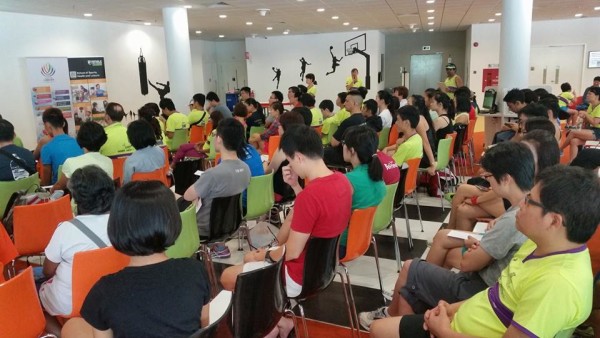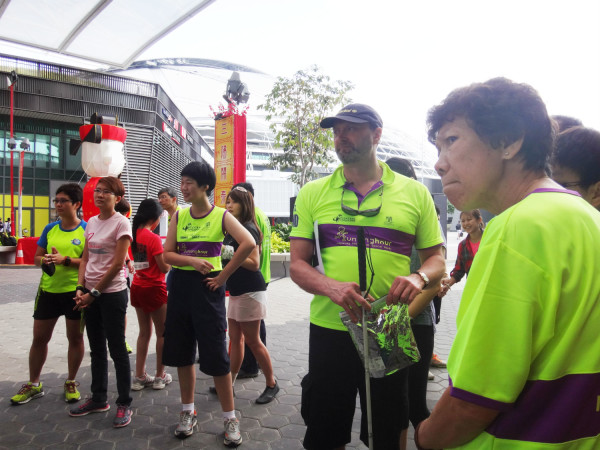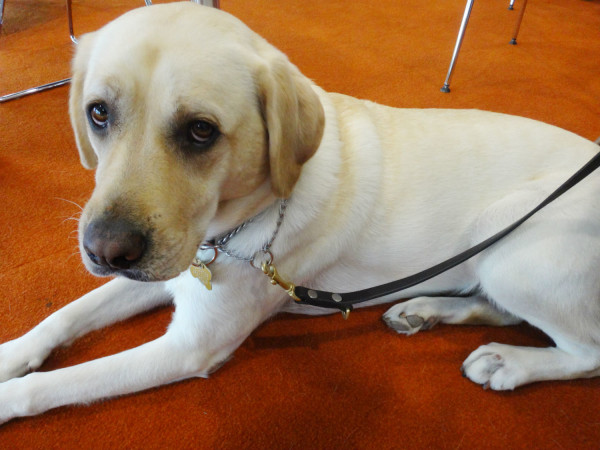The moment the blindfold came on, I was immediately overcome with a sense of insecurity. Without my eyes to tell me where I was going, I felt as though I didn’t want to move, let alone run, for fear of bumping into things or falling flat on my face. Fortunately though, I had a running ‘guide’ and Kate, was very understanding. She did a really great job of guiding me around the Singapore Sports Hub for the next 10-20 minutes. But still, it was a sheer relief to me, when I finally completed the short run and was able to take off the blindfold and get my sight back.
That was my harsh introduction to what running feels like for a visually challenged person – at a RunningHour integration workshop held last Saturday.
This clinic was the third and final workshop, which gave the general public an insight into the world of visually impaired running – ahead of the inaugural RunningHour race, which takes place later this month, on 22 March. This race will feature Singapore’s first 5km and 10km Blind Run, where participants will run 500m of the respective race routes blindfolded and another 500m acting as a running guide to a buddy runner.
Promotes the well-being and integration of the visually impaired and other special needs runners
RunningHour, which started in April 2009, is a sports co-operative that promotes the well-being and integration of visually impaired and other special needs people, into mainstream sports.
Said John See Toh, 54, the Chairman of RunningHour, “I think it is challenging for people to run blindfolded, and to experience what visually challenged runners are feeling. We organised this race and the three workshops, to build empathy for those with visual impairment. In this way, we hope to get people to understand more about the challenges faced by the visually impaired runners.”
Added Ong Meng Hong, 44, who is an Ex-Co member of the RunningHour running committee, “For people who just sign up for the run, turning up on the day and blindfolding themselves to run, they may not fully gain an awareness of what RunningHour is all about and what we do. So that’s why we decided to hold these integration workshops to let interested people know more about us, and provide information about guiding special needs runners.”
Participants found running blind to be an interesting experience
Many of the participants at last weekend’s workshop found the blind run a very challenging but interesting experience. Said Lynn Yap, 51, a personal assistant, “I was worried about falling or bumping into something or someone. I needed a lot of assurance from my partner and I kept asking him whether the front road is clear of people or obstacles. He was quite soft-spoken so with the noisy surroundings, I couldn’t hear him clearly and that worried me. But when I requested him to speak louder, he responded with louder instructions and we completed the blind run smoothly.”
She added, “We were able to bring our partner to finish the run today – thus building a relationship in that few minutes of contact, which is usually not possible in normal circumstances. For special needs runners in similar situations, it fulfils their wish to run – thus bringing cheer to them. I too, hope to be able to do this in the long run.”
An enriching workshop experience
At the workshop, besides finding out what it feels like as a visually impaired runner, we also got the chance to act as a guide to a blindfolded runner. In addition, we also got to learn about other problems that both visually impaired and intellectually challenged runners face while running and how to encourage them to keep on going.
As well, we were able to mingle with some of the visually impaired and also intellectually challenged runners at the integration workshop. To me, it was a very enriching experience and I found many of the intellectually challenged people there were shy of strangers, yet extremely vocal and outspoken towards people whom they are familiar with. My short encounter was enough to whet my curiosity on what makes these people tick.
Many of the workshop participants also learnt a lot from the rest of the RunningHour integration clinic as well. Said Yap, “I really learnt how to befriend the visually and intellectually challenged runners and take care of them during running. I also learnt simple routines that we may take for granted but are a challenge for them. So I am now more understanding of their needs.”
Hopes to make RunningHour into a household name one day
Yap’s words would definitely echo well with See Toh, who eventually hopes to make RunningHour into a household name. He said, “We want to create more awareness of RunningHour, through this race, and reach out to recruit more people with special needs and integrate them into the mainstream society.”
Regular training sessions on Saturday mornings
Besides the integration workshops and the running race, RunningHour also has regular training sessions every Saturday mornings, whereby members of the public, in addition to special needs people, can also drop by to help out and get a first-hand glimpse into running together.
Explained Ong, “It is natural to feel apprehensive. The first time I had heard of RunningHour, about a year ago, I joined up and told them I hoped to help but I didn’t know anything about guiding a blind person. During the first few sessions, you will feel lost but after one to two months, you will feel very comfortable with us.”
For special needs people, they should also feel free to get in touch with RunningHour, according to See Toh. He said, “If anyone is reading this blog and knows someone with special needs, you should get them to contact us, so that we can phase them in slowly. You do not need to be scared to run if you are not a runner. If you like, you can start with walking.”
Find out more about RunningHour at https://runninghour.wordpress.com.




Leave a Comment